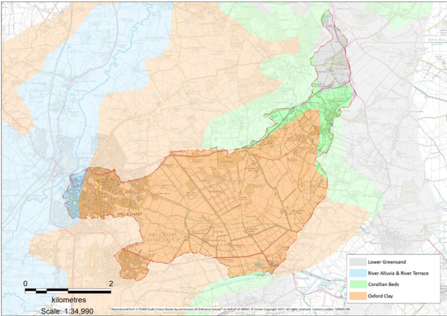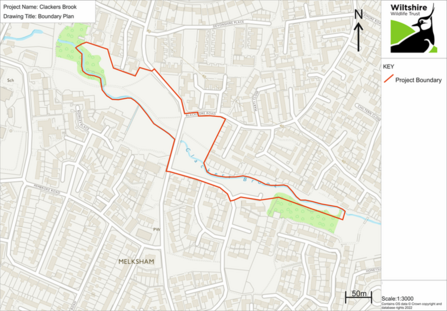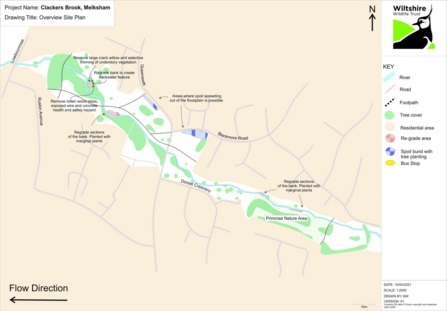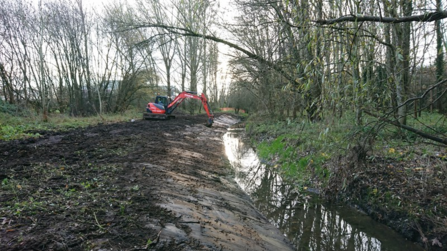Restoring the Clackers Brook
The Water Team at Wiltshire Wildlife Trust have developed designs, in consultation with Wiltshire Council, Selwood Housing and Melksham Town Council, to enhance the Clackers Brook for wildlife and people around Queensway Bridge, Melksham.
Clackers Brook
The Clacker’s Brook has a small length of approximately 8.5km, rising near Bromham and flowing through a mixture of arable and pasture land before reaching Melksham. Here, on the very western edge of the town, the brook is joined by two small tributaries before flowing through Melksham, where it ultimately joins the Bristol Avon by the Town Bridge. The geology of the catchment is dominated by clay with areas of limestone and greensand in the headwaters to the north east.

Why restore the Clackers Brook?
Rivers, brooks, streams and their banks are important wildlife corridors. They act as highways for all manner of wildlife, linking up important habitats, and allowing wildlife to safely travel between them. Rivers also provide incredibly valuable habitat in their own right. They support numerous species of fish, mammals, birds and a wonderful array of invertebrates. This, in addition to a characteristic community of wildflowers and wet loving plants.
However, over the years, many of our rivers, brooks and streams have been straightened and canalised. Riverbanks in particular have been modified and ‘constrained’ by agricultural and urban development resulting in a riverside habitat with little value to wildlife.
Unfortunately, the Clackers Brook is no exception. This had led to it being rated as ecologically “poor” under the latest Water Framework Directive classification. We aim to address this by creating space for wildlife that doesn’t currently exist providing a high quality green space for people and wildlife to enjoy, focusing on the area around Queensway Bridge.

What have we done to get where we are?
To get to the stage we are we’ve undertaken a wealth of surveys and site visits to the area. These have included topographical surveys of the brook, protected species surveys (including water vole and otter surveys), soil testing, service searches, numerous site visits with stakeholders as well as presentations at public meetings. All of this has been fed into the design process.
What will the project involve?
The designs include:
- The re-profiling of 4 small sections of riverbank (total 75m). This will create marginal habitat, to be colonised by riparian wildflowers, for invertebrates and water voles.
- Subsequent plug planting of regraded marginal areas. To be completed by local volunteers from schools and community groups (in the following spring). Plants to include but not limited to Purple Loosestrife, Kingcup, Meadowsweet, Yellow Flag Iris.
- The spreading of material outside the floodplain. Spoil to be seeded and spread to blend in with surroundings.

We plan to deliver the bulk of the work in late summer or early autumn when ground conditions are at their driest and the bird breeding season has finished. Once a date is agreed this will be circulated, the project is currently going through the relevant permitting and planning processes. Work will be undertaken with one excavator and one dumper which will require small sections of the project area to be cordoned off for safety whilst delivery is taking place. It must be stressed that at no point will this limit thoroughfare and access. Site maps and advance warning signs will also be displayed prior to work being undertaken.
What is riverbank re-profiling?
The following pictures were taken during a previous restoration project we completed in Swindon. These are an example of riverbank re-profiling, and is what we aim to replicate in the four areas on the Clackers Brook.
In the first picture the banks of the stream are very steep where the grassy bank top drops immediately down into the stream channel. This means there is very little space for marginal vegetation and a whole habitat which provides food and refuge to invertebrates, amphibians and mammals including water voles is missing. This is not dissimilar to the current situation on some sections of the Clackers Brook through Melksham.

In the second picture the new bank profile is visible. Here the bank has been made into a gentle slope, creating marshy wet lying areas that are the perfect habitat for marginal plants and wildflowers to flourish. A whole new habitat has been created ready to for planting. It must be stressed that this isn’t dredging, re-profiling begins above the water level and no channel sediments are disturbed.

How to get in touch?
Please direct any questions, queries or comments to water@wiltshirewildlife.org and we will get back to you.
